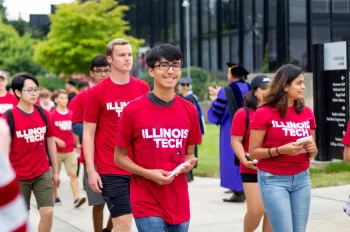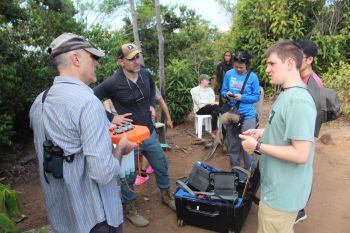Illinois Tech Biomedical Engineering Professor Funded to Find Treatment for Chronic Wounds Among Diabetics
Illinois Institute of Technology professor of biomedical engineering Georgia Papavasiliou and her team are developing a novel ointment to treat injuries that fail to heal
CHICAGO—Illinois Tech professor of biomedical engineering Georgia Papavasiliou and her team have received a second round of funding from the Pilot and Feasibility Program Award program at University of Chicago’s Diabetes Research and Training Center for their work developing a novel ointment to treat chronically infected diabetic wounds that fail to heal. The program aims to promote new research discoveries and enhance scientific progress by supporting cutting-edge basic and clinical research on the causes of diabetes and its complications.
Studies have shown that managing diabetes-related foot disease in the United States costs up to $13 billion annually.
“The complications of unhealed diabetic wounds that remain infected are actually devastating,” says Papavasiliou. “Bacterial infection, ulceration, and loss of blood supply are characteristic features of the wound bed of the diabetic patient. This leads to deep tissue infection and destruction and is the leading cause of lower extremity amputation.”
Papavasiliou’s co-investigators are S.C. Johnson Professor of Chemical Engineering Fouad Teymour and Associate Professor Seok Hoon Hong from the Department of Chemical and Biological Engineering.
Wound healing is highly coordinated by a variety of cell types in the body that play a critical role in healing. Diabetes impairs the functionality of cells that regulate the natural healing process including loss of white blood cells to ward off bacterial infection and decreased functionality of cells that promote blood vessel growth to deliver nutrients and remove wastes from the wound.
Although strategies to increase blood flow and deliver oral and topical antibiotics are the mainstay of therapy for chronic diabetic wounds, amputation rates remain steady and costs of chronic care continue to increase.
Most diabetic wounds develop a bacterial biofilm, a collection of bacteria that coexist together in an enclosed, self-produced glue-like substance that makes bacteria stick together as well as to surfaces, including the wound bed.
Papavasiliou says biofilm is “extremely difficult to eradicate” in the diabetic patient because it will quickly regrow after being removed due to the decreased blood supply and loss of white blood cells leaving the wound vulnerable to reinfection. In addition, bacterial biofilms are challenging to eliminate because they are inherently resistant to antibiotic treatments.
Papavasiliou has been collaborating with Hong, a biofilm expert, to identify compounds that will both disperse an existing biofilm and suppress its regrowth.
Existing ointments tend to either contain antibiotics focused on killing bacteria that exist individually, not as biofilms, or therapeutics that promote the growth of blood vessels in the wound bed.
Complete healing, however, requires controlled delivery of therapeutics that eradicate biofilms and promote blood vessel growth simultaneously. The wound can’t heal if infected with bacterial biofilm, and an uninfected wound bed without sufficient vascularization won’t close, inevitably leading to reinfection.
“It’s a vicious cycle that prevents the wound from healing,” says Papavasiliou. “I think having a product that can actually deliver therapeutics together in a very, very precise way, with one ointment, is the way to go.”
These ointments can be used along with current standard-of-care practices to improve diabetic wound healing.
Rethinking the process from the ground up, the team’s approach examines the problems with current ointment manufacturing processes and forges a new path for controlled and sustained delivery of multiple therapeutics from a single ointment.
Papavasiliou and Teymour developed a polymerization process to produce biocompatible ointments that contain multiple types of hydrogel nanoparticles within them. Each nanoparticle type can be precisely constructed to encase each drug and release it for the desired duration needed to perform its therapeutic mechanism of action.
Additionally, the nanoparticle production process uses fully biocompatible components which circumvents the need for post-production processing prior to their use and are shelf-stable for prolonged periods of time.
Finally, the nanoparticles are produced within the ointment phase, and the entire product can be delivered directly to wounded tissue to release the drugs on a set schedule for up to 40 days.
The team is currently testing a version of the ointment that contains three drugs with different functions, aiming to eradicate biofilms and, at the same time, promote blood vessel growth to stop the cycle of reinfection.
“We thought it would be nice to optimize something from the very beginning, that’s purely biocompatible, and that requires no extra steps for processing,” she says. “That’s something that’s very unique and no one’s really thought about before.”
This means almost all of the drug that goes into the product makes it to the patient, plus it has allowed her to create a product with a longer shelf-life and with the potential for a most cost-effective manufacturing process due to the increased costs of therapeutics.
Through this work, Papavasiliou aims to create a foundation that could improve the delivery of a range of treatments, for diabetes patients and beyond.
Shadi Motamed (M.S. BME candidate) and Fatima Rizwan (Ph.D. CHE candidate) are contributors to this research.
Disclaimer: “Research reported in this publication was supported by the National Institutes of Health’s National Institute of Diabetes and Digestive and Kidney Diseases-sponsored University of Chicago Pilot & Feasibility Program Award Number DK020595. This content is solely the responsibility of the authors and does not necessarily represent the official views of the National Institutes of Health.”
Georgia Papavasiliou, “Biocompatible Nanoparticle Emulsions for Healing Chronic Diabetic Wound Infection,” National Institutes of Health; Award Number DK020595.
Photo: Professor of Biomedical Engineering Georgia Papavasiliou
Illinois Institute of Technology
Based in the global metropolis of Chicago, Illinois Tech was born to liberate the collective power of difference to advance technology and progress for all. It is the only tech-focused university in the city, and it stands at the crossroads of exploration and invention, advancing the future of Chicago and the world. It offers undergraduate and graduate degrees in engineering, computing, architecture, business, design, science and human sciences, and law. Illinois Tech students are guaranteed hands-on experiences, personalized mentorship, and job readiness through the university's one-of-a-kind Elevate program. Its graduates lead the state and much of the nation in economic prosperity. Its faculty and alumni built the Chicago skyline. And every day in the living lab of the city, Illinois Tech fuels breakthroughs that change lives. Visit iit.edu.
Armour College of Engineering
Armour College of Engineering has been educating world-class engineers since the university’s founding in 1890. As future engineers who will innovate in the twenty-first century, Armour students learn the principles of the profession and work in an interdisciplinary environment that emphasizes hands-on learning, teamwork, and leadership, all through the lens of our four engineering themes—water, health, energy, and security—that highlight issues vital today and in the future. Armour is home to five departments and nine ABET-accredited undergraduate majors, which provide a wide breadth of exciting programs from which to choose. Illinois Tech alumni have advanced to careers as presidents of companies and professors at major universities—and have become members of the National Academy of Engineering, the highest distinction in the field.
Media contact
Kevin Dollear
Communications Manager
Illinois Institute of Technology
Cell: 773-860-5712
kdollear@iit.edu




